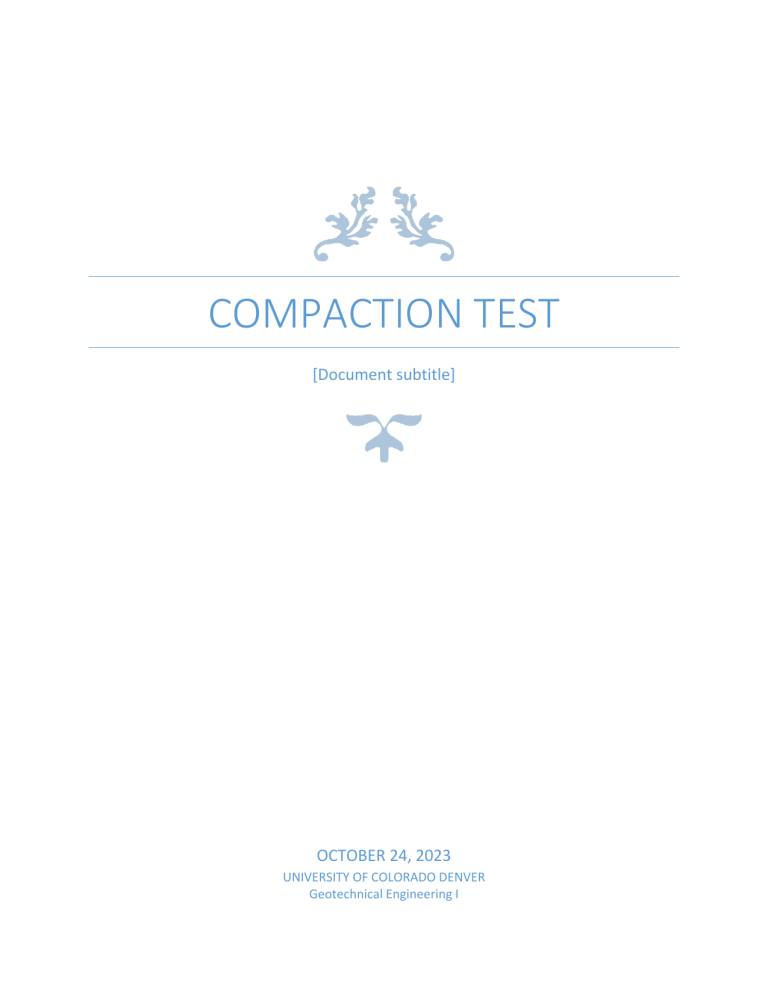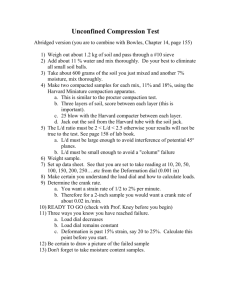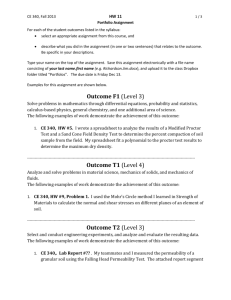
COMPACTION TEST [Document subtitle] OCTOBER 24, 2023 UNIVERSITY OF COLORADO DENVER Geotechnical Engineering I Table of Contents 1. COMPACTION TEST (STANDARD AASHTO) ........................................................................................... 2 1.1 OBJECTIVE ..................................................................................................................................... 2 1.2 TEST PURPOSES ............................................................................................................................. 2 1.3 APPARATUS ................................................................................................................................... 3 1.4 PROCEDURE .................................................................................................................................. 3 1.5 PRECAUTIONS ............................................................................................................................... 4 1.6 FACTORS AFFECTING THE RESULTS OF COMPACTION TEST ......................................................... 5 1.7 OBSERVATIONS AND CALCULATIONS ........................................................................................... 5 1.8 RESULTS......................................................................................................................................... 6 1 1. COMPACTION TEST (STANDARD AASHTO) 1.1 OBJECTIVE The purpose of this standard compaction test is to determine the soil's moisture density relationship for a certain compactive effort. 1.2 TEST PURPOSES Compaction is a form of mechanical stabilization in which mechanical energy, also called compactive effort, is applied to a mass of soil in order to make it denser. Dynamic load, static load, vibration, and tamping are all viable options for generating the necessary mechanical energy. When soil is compacted, the particles are pushed around and the air volume is decreased. There are three (03), significant impacts caused by soil compaction's increase in density: 1. The soil's shear strength increase 2. Decrease in the future settlement, 3. Decrease in the Permeability All construction projects must consider these three consequences. The advantages, as a whole, tend to amplify as the degree of compacting rises. Soil compaction is a cost-effective and straightforward method for enhancing soil quality. The estimation of compaction level can be derived from the density of the soil, which is commonly referred to as its dry unit weight. In order to enhance the density of arid soil by compaction, it is advisable to introduce a certain quantity of water to each distinct soil type individually. Water functions as a lubricating agent, facilitating the densification of soil particles through increased compaction. Put simply, there exists an optimal level of moisture that allows for the driest density to be achieved with the least amount of compaction work. The moisture level and dry density might be conceptualized as the "Optimal Moisture Content" and "Maximum Dry Density," respectively. Conducting laboratory compaction tests on representative samples obtained from the construction site is a customary procedure within the construction industry. These studies aim to ascertain the Optimal Moisture Content and Maximum Dry Density, which are crucial parameters for building projects. The determination of design shear strength, future settlement resistance, and permeability necessitates the utilization of Maximum Dry Density by the designer. The soil is subsequently compressed in the field to achieve an equivalent Maximum Dry Density (or percentage) as was achieved during laboratory testing. The verification of the Maximum Dry Density (or a proportion thereof) can be achieved by the utilization of in-situ soil density testing. 2 There exist two distinct methodologies for establishing the correlation between moisture content and density: 1. The AASHO Standard Proctored Exam. 2. Exam in a modified Proctor (AASHO-like) 1.3 APPARATUS 1. The height, internal diameter, and volume of a compaction mould measuring 4.58 inches, 4 inches, and 0.30 cubic feet, respectively. 2. A common compaction rammer (weighing 5.5 lbs and dropping 12 inches) 3. Moisture tins 4. Big spoon for stirring 5. Large spoon for mixing 6. Knife for trimming 7. Steel straight edge 8. Oven for drying 9. Scales for weighing (Least count = 0.01 gram) 10. Scales for weighing (Least count = 1.0 gram) 1.4 PROCEDURE 1. Gather a sample of dirt that passes the U.S. No. 4 sieve and has been air-dried to a weight of around 3 kilograms. If you must break up the material, do so in a method that causes as little stress as possible on the soil particles. 2. After determining the soil sample's dry weight through analysis, add water until the desired consistency is reached. Sandier soils should have around 7% water added to them compared to the dry weight, whereas clayier soils should have about 10% water added to them relative to the dry weight. To hasten the soil's development, it's best to keep it in a sealed container for 20 hours, during which time a hermetic atmosphere can be maintained. 3. When compared to the collar and the base plate, the compaction mould must be lighter. 4. It is necessary to take a measurement of the compaction mold's volume. Join the mold's collar and base plate together. 5. The standard compaction method should be used during the soil compaction process. The compaction procedure should be carried out in three uniform layers, with 25 blows from a 5.5-pound rammer dropped from a height of 12 inches landing on each layer. It is crucial to make sure the effects permeate all levels equally. Soil should be used to fill the mould, with a small excess of about 14 inch that may be removed when the collar is taken off. 3 6. Be careful when taking off the collar and the bottom plate. Use a straight edge to strike the top and bottom of the cylinder of compacted earth. Extra soil should be added to the crushed specimen if there are any gaps inside. 7. First, you need to get rid of the mould growing on the outside, and then you may weigh it to within a gramme. 8. To determine the soil's moisture content, we need to remove the cylinder of soil from the mould, divide it, and then remove a sample. 9. The presented material needs to be separated into particles small enough to fit through a No. 4 sieve. Additionally, 2 percent of the sample's starting weight in water should be added. After reaching a peak value as indicated by wet weights, the process should be restarted and replicated until two slightly lower compressed weights are achieved. 10. The following day, take the water content samples that were dried in the oven and bring them to the lab for analysis. This will allow for precise measurement of water content in each sample. 11. The purpose of this research was to provide a visual representation of the saturation curve, often known as the zero air void line. 1.5 PRECAUTIONS 1. Blows should be delivered consistently throughout all soil levels. 2. Do not add dirt to fill in the mould if the last compacted layer did not reach over the collar joint. Try the test again and again. 4 1.6 FACTORS AFFECTING THE RESULTS OF COMPACTION TEST Several factors will determine how much of a compact may be achieved: i. Soil type (sandy or clay), texture (fine or coarse), and adaptability ii. Compaction-time water content iii. Environmental, topographical, and stratigraphic features of the site iv. Both the plant's characteristics and the amount of work put in to compact the soil are factors. 1.7 OBSERVATIONS AND CALCULATIONS Water Content Determination Sample No 1 2 3 4 5 Moisture cup no. B1 B2 B3 B4 B5 B6 B7 B8 B9 B10 Mass of cup + wet soil (g) 43 53 38 46 35 36 54 47 49 48 Mass of cup + dry soil (g) 39 48 34 42 31 33 45 41 41 41 Mass of water, Mw (g) 4 5 4 4 4 3 9 6 8 7 Mass of cup (g) 11 11 11 12 12 12 12 11 11 11 Mass of dry soil, Ms (g) 28 37 23 30 19 21 33 30 30 30 Water content, w (%) 14.29 13.33 21.05 14.29 27.27 13.51 17.39 20.00 26.67 23.33 Unit weight determination Water Content , w(%) average Mass of soil + mold (kg) Mass of mold (kg) Mass of soil in mold (kg) Mass of soil in mold (lb) Wet unit weight (lb/ft3) Dry unit weight (lb/ft3) 13.90 15.36 17.67 23.64 25.00 3.76 3.82 3.945 3.92 3.9 1.989 1.989 1.989 1.989 1.989 1.771 1.831 1.956 1.931 1.911 3.904 4.037 4.312 4.257 4.213 117.130 121.099 129.366 127.712 126.390 102.837 104.972 109.940 103.297 101.112 5 RESULTS Dry unit weight (lb/ft3) 1.8 111.000 110.000 109.000 108.000 107.000 106.000 105.000 104.000 103.000 102.000 101.000 100.000 0.00 5.00 10.00 15.00 20.00 25.00 30.00 Water Content (%) Maximum dry unit weight = γdmax. = 110 (lb/ft3) Optimum Moisture Content = OMC = 18% Note: The optimum moisture content (OMC) is defined as the moisture level at which the dry unit weight or dry density are both maximised. 6




